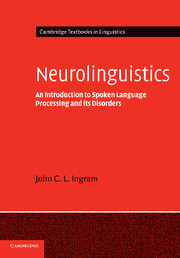Book contents
- Frontmatter
- Contents
- List of figures
- List of tables
- Preface and acknowledgements
- Note on the text
- Part I Foundational concepts and issues
- Part II Speech perception and auditory processing
- Part III Lexical semantics
- Part IV Sentence comprehension
- Part V Discourse: language comprehension in context
- Glossary
- References
- Index
Preface and acknowledgements
Published online by Cambridge University Press: 26 January 2010
- Frontmatter
- Contents
- List of figures
- List of tables
- Preface and acknowledgements
- Note on the text
- Part I Foundational concepts and issues
- Part II Speech perception and auditory processing
- Part III Lexical semantics
- Part IV Sentence comprehension
- Part V Discourse: language comprehension in context
- Glossary
- References
- Index
Summary
This book is intended as a self-contained introduction to the study of the language–brain relationship for students of cognitive science, linguistics and speech pathology. The essentially interdisciplinary nature of the subject matter posed considerable difficulties for the author and will likely do so also for the reader. So please be warned. Despite my considerable efforts to keep the pathways open between the villages of the cognate disciplines concerned, the jungle is everywhere and its capacity for re-growth is relentless.
As appropriate for an introductory text, the book is accessible to a wide readership. Foundational concepts and issues on the nature of language, language processing and brain language disorders (aphasiology) are presented in the first four chapters. This section of the book should be complementary with many stand-alone introductory courses in linguistics, psychology or neuroanatomy. Subsequent sections deal with successively ‘higher’ levels of language processing and their respective manifestations in brain damage: speech perception (chapters 5–8); word structure and meaning (lexical processing and its disorders; chapters 9–11); syntax and syntactic disorder (agrammatism; chapters 12–14); discourse and the language of thought disorder (chapters 15–16), followed by a brief final chapter, speculating on unsolved problems and possible ways forward. Each major section of the book begins by posing the principal questions at an intuitive level which is hopefully accessible to all. The often quite specialized research methods by which answers to these questions have been sought are then introduced, in a selective review of the literature.
- Type
- Chapter
- Information
- NeurolinguisticsAn Introduction to Spoken Language Processing and its Disorders, pp. xix - xxPublisher: Cambridge University PressPrint publication year: 2007



